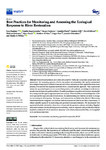Best Practices for Monitoring and Assessing the Ecological Response to River Restoration
| dc.contributor.author | England, J | en |
| dc.contributor.author | Angelopoulos, N | en |
| dc.contributor.author | Cooksley, S | en |
| dc.contributor.author | Dodd, J | en |
| dc.contributor.author | Gill, A | en |
| dc.contributor.author | Gilvear, D | en |
| dc.contributor.author | Johnson, M | en |
| dc.contributor.author | Naura, M | en |
| dc.contributor.author | O’Hare, M | en |
| dc.contributor.author | Tree, A | en |
| dc.contributor.author | Wheeldon, J | en |
| dc.contributor.author | Wilkes, MA | en |
| dc.date.accessioned | 2021-12-10T11:33:08Z | |
| dc.date.available | 2021-12-10T11:33:08Z | |
| dc.date.issued | 2021-11-26 | en |
| dc.identifier.other | 3352 | en |
| dc.identifier.uri | http://hdl.handle.net/10026.1/18458 | |
| dc.description.abstract |
<jats:p>Nature-based solutions are widely advocated for freshwater ecosystem conservation and restoration. As increasing amounts of river restoration are undertaken, the need to understand the ecological response to different measures and where measures are best applied becomes more pressing. It is essential that appraisal methods follow a sound scientific approach. Here, experienced restoration appraisal experts review current best practice and academic knowledge to make recommendations and provide guidance that will enable practitioners to gather and analyse meaningful data, using scientific rigor to appraise restoration success. What should be monitored depends on the river type and the type and scale of intervention. By understanding how habitats are likely to change we can anticipate what species, life stages, and communities are likely to be affected. Monitoring should therefore be integrated and include both environmental/habitat and biota assessments. A robust scientific approach to monitoring and appraisal is resource intensive. We recommend that appraisal efforts be directed to where they will provide the greatest evidence, including ‘flagship’ restoration schemes for detailed long-term monitoring. Such an approach will provide the evidence needed to understand which restoration measures work where and ensure that they can be applied with confidence elsewhere.</jats:p> | en |
| dc.language | en | en |
| dc.language.iso | en | en |
| dc.publisher | MDPI AG | en |
| dc.title | Best Practices for Monitoring and Assessing the Ecological Response to River Restoration | en |
| dc.type | Journal Article | |
| plymouth.issue | 23 | en |
| plymouth.volume | 13 | en |
| plymouth.journal | Water | en |
| dc.identifier.doi | 10.3390/w13233352 | en |
| plymouth.organisational-group | /Plymouth | |
| plymouth.organisational-group | /Plymouth/Faculty of Science and Engineering | |
| plymouth.organisational-group | /Plymouth/Faculty of Science and Engineering/School of Geography, Earth and Environmental Sciences | |
| plymouth.organisational-group | /Plymouth/REF 2021 Researchers by UoA | |
| plymouth.organisational-group | /Plymouth/REF 2021 Researchers by UoA/UoA14 Geography and Environmental Studies | |
| plymouth.organisational-group | /Plymouth/Users by role | |
| plymouth.organisational-group | /Plymouth/Users by role/Academics | |
| dcterms.dateAccepted | 2021-11-21 | en |
| dc.rights.embargodate | 2021-12-11 | en |
| dc.identifier.eissn | 2073-4441 | en |
| dc.rights.embargoperiod | Not known | en |
| rioxxterms.versionofrecord | 10.3390/w13233352 | en |
| rioxxterms.licenseref.uri | http://www.rioxx.net/licenses/all-rights-reserved | en |
| rioxxterms.licenseref.startdate | 2021-11-26 | en |
| rioxxterms.type | Journal Article/Review | en |


